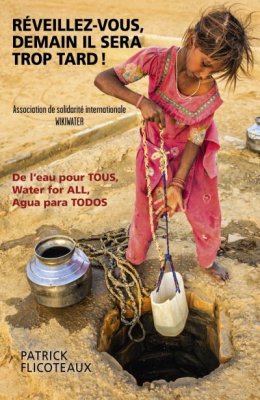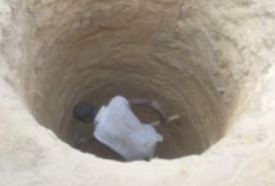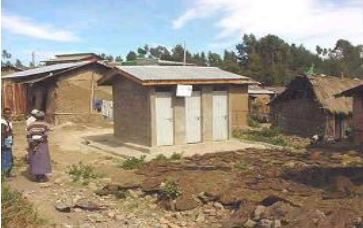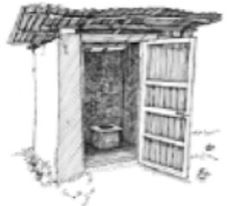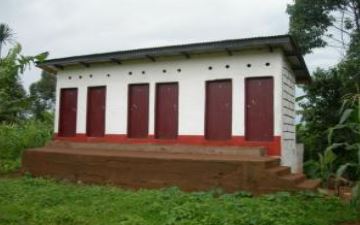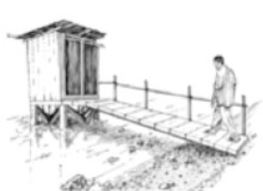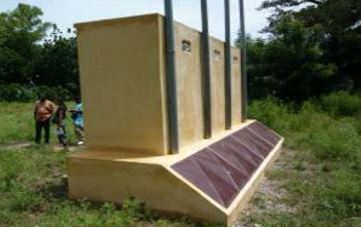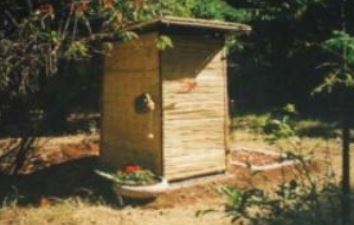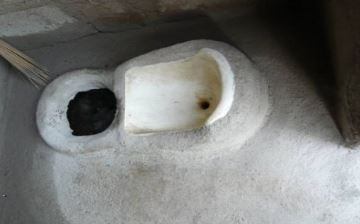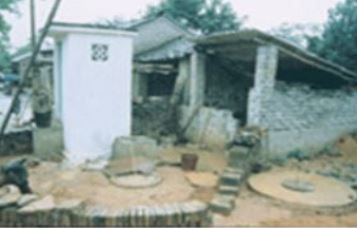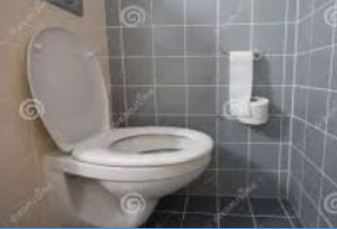1) What is involved ?
In areas not provided with individual sanitation facilities (toilets connected to a sewer, a septic pit, family latrines, etc.), which is mainly the case of rural or suburban areas, access to sanitation may be provided through the installation of community latrines. In the latter case, this thus involves building groups of latrines that may be common to a group of households in poor neighbourhoods. It also includes public latrines to be located in the village centre or in places of business (market, bus station, etc.). Similar collective sanitation systems also need to be built in schools. They should be designed to ensure proper operation under suitable conditions of hygiene and privacy for users.
2) Why should this means be used ?

Defecating in the open air. WEDC
Defecation outside in the open air, which is still a fairly common practice (1.2 billion people) needs to gradually disappear for reasons of hygiene and dignity. It also contaminates the soil and water supply sources. Faeces may also form sources of infestation where insects proliferate and spread infection. It is thus essential to create latrines for communities that do not have family latrines, as well as in public places and schools.
The installation of community latrines is also generally motivated by economic reasons (to serve as many people as possible with minimal investment) and to save space : in densely populated areas, the installation of a latrine for each family quickly becomes technically problematic.
The installation of latrines in schools, provided that they are properly maintained, is essential since children are particularly vulnerable to the adverse effects of poor sanitation conditions and lack of hygiene. It is also an important factor in education, especially for girls, many of whom, as has been often observed, leave school after puberty due to the lack of latrines.
3) Who is primarily concerned ?
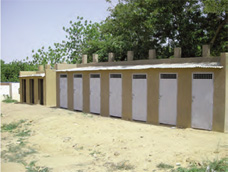
Group of 7 latrines in Burkina Faso
All the populations in all countries worldwide are concerned by the installation and maintenance of sanitary facilities in public places. The management method and the sanitation processes used will differ according to local circumstances.
The main public spaces concerned are schools, public places of communal activity and rural areas or neighbourhoods in particular on the outskirts of towns in poor regions where people do not have individual sanitation systems and would otherwise be forced to defecate outdoors.
4) What does this process involve ? How is it used ?
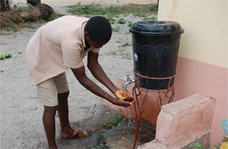
Plastic washbasin on a metal support
The type of latrine to be used can range from the simplest (pit latrines) to the most modern type (flush latrines with siphon) and including VIP type ventilated latrines or Ecosan latrines. Fact sheets A5 to A12 describe the various types of latrines and provide the information (usage, cost, suitability for specific circumstances, advantages and disadvantages) needed to choose the most suitable system based on the available budget and local conditions for supplying drinking water and effluent disposal. Several latrines can be connected to one or two pits.
A collective sanitation system must comply with several principles, regardless of its use. Firstly, it should not be built near a well or a borehole as it is a potential risk of pollution. For privacy and culture reasons, it must include two groups of separate latrines, one for men and one for women. A place provided with an access to water, through a drinking water system or tanks regularly filled, for example, from a well with a hand pump, should be available to provide good hygiene practice by washing hands with soap and water and for anal cleansing.
Sanitary facilities for community use are unfortunately rarely designed to facilitate access for the elderly, handicapped and disabled. This need will hopefully not be forgotten. All that needs to be provided is an access ramp and grab bars and, if possible, a raised seat in a stall dedicated for the disabled in each boys/girls unit.
The number of latrines will depend on the number of users in the case of community use and the number of pupils for a school. Some facilities take as a standard one latrine for 50 pupils, with at least one more separate latrines for teachers, which is insufficient when all the pupils need to use them at the same time. Other types recommend having at least one latrine for 25 to 30 girls and one latrine for 50 to 60 boys with the providing of urinals.
The design of a community facility should take account of the emptying frequency and method which will determine the sizing of pits and the access mode for emptying trucks.
5) Precautions to be taken
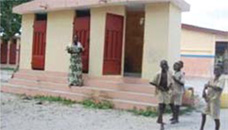
ECOSAN latrine in a school
Reference should be made to the fact sheet (see fact sheets A5 to A12) corresponding on the type of latrines to be built, so as to take account of the specific recommended precautions. Building latrines in schools is not enough to solve the problems of sanitation and disease prevention. These latrines also have to be appropriately designed and properly used and maintained, which is not always the case
With the construction of latrines or sanitary facilities for school or community use, it is essential to take account of the way they are used and managed. If they are dirty and in poor working condition, they will end up by no longer being used. Future users must thus be made aware of the importance of keeping them clean and following the basic rules of hygiene.
This is especially true for school children. Hygiene education in schools is crucial as schools have long been regarded as the normal place for educating children and their families in good hygiene practices. The building of such facilities therefore must necessarily be accompanied by information given by the municipality for community use in public places and by the school’s head teacher for school latrines. The information regarding the cleaning of latrines and personal hygiene will only be acted upon if each toilet block is effectively provided with access to soap and water and the person responsible for cleaning has the equipment and products needed.
6) Main advantages and drawbacks
a) Advantages
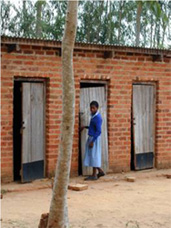
Photo by Pro-Action Dévelopment in Mali
If well designed and well maintained, community sanitary facilities provide a solution for the sanitation of populations in schools and public places. The advantages are especially important for children :
- Education in hygiene which reduces diseases
- Better school attendance, especially for girls
b) Drawbacks
- The method used to manage and maintain community facilities pose problems in terms of staff and cost
- The maintenance of school facilities is often inadequate or poorly received when it is done by pupils.
7) Cost
Fact sheets A5 to A12 provide individual cost estimations varying according to the type of latrine chosen, the quality of the materials used, the depth of the pit, the type of superstructure or interior layout and the region. The cost of a block of N latrines is not quite equal to N times the unit cost as it includes the common walls and the fact that it is not possible to arrange for a single pit with a larger volume to be connected to several latrines. There is also a scale effect that reduces the cost of labour.
8) Places or contexts in which this technique appears to be the best suited
Sanitary facilities are essential in all public places, such as schools or health centres. The same applies to any village or neighbourhood where many homes are not provided with a family sanitation system.
9) Observations, recommendations and suggestions
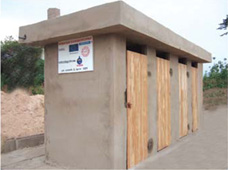
VIDP latrine with four (4) stalls
Several surveys have questioned the relevance of building "twin pit" latrines. The two pits are often used simultaneously which goes against the very principle of the twin pit which means that once one of the pits is full, the hole is blocked for some time to allow the pathogens present in excreta to be removed naturally before the full pit is emptied.
It is necessary to ensure that the lighting of sanitary facilities ensures sufficient brightness during the day. Connection to the power grid is the best solution to provide night lighting. An interesting idea arose in relation to the superstructure of latrines in Burkina Faso A few empty glass bottles, built into the walls between the bricks, allow light in but cannot been see through.
Special attention should be paid to the choice of equipment which is placed under considerable strain and thus needs to be very robust. After a few years, metal doors are frequently seen not to be sealed or no longer close, when they are not just simply stolen. The alternative is to install baffles to provide a degree of privacy.
With the building of sanitary facilities for community use in poor neighbourhoods, the installation of showers can often be considered, what provides the population with an additional service.
10) Achievement example
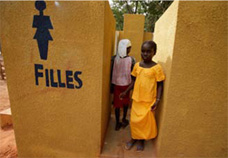
Photo by UNICEF
Improved sanitation facilities in Rwanda
The Murama children’s school in the Bugesera District has a new approach to hygiene. Here, the improved toilets and water facilities have made a great difference in terms of girls starting and continuing on at school. In Murama, pupils have hygienic latrines, running water, soap, and sanitary towels for girls. The importance of health and hygiene is instilled into pupils, in the hope that they will pass on these ideas to their families and communities. The Murama headmaster expressed his enthusiasm about the improvements in his school’s hygiene, emphasising their positive effect on pupils, in particular as regards girls’ education.
11) Where to obtain further information - Bibliography
a) Websites
- ENVIRO-BF : At a time when most sanitation projects include a "school latrines" aspect, the results of a Hydroconseil survey provide insight into the specific issues related to the management of such collective facilities, for which the national office is not responsible, and the level of satisfaction of those who use them, and above all, the pupils. Available on line (one page) at :
http://www.envirobf.org/dossiers-sp...
- PSEau : This very detailed, illustrated 82-page guide entitled "Managing public toilets and showers" focuses on the conditions for good management of sanitary facilities : proper design of structures and hygiene promotion and provides valuable information.
http://www.pseau.org/outils/biblio/...
- UNICEF : Detailed case study summarised in two pages : "The promotion of sanitation and hygiene in schools in Malawi". http://www.unicef.org/french/wash/i...
- BELGIAN DEVELOPMENT AGENCY : Example of a programme to build 1000 ecological latrines for 70,000 pupils in 80 schools in Rwanda.
http://www.btcctb.org/fr/casestudy/...
- WEDC : This 5-page fact sheet, illustrated with drawings, photos and diagrams, in English, entitled "Inclusive design of school latrines" first indicates the design and standard drawings for latrine units, but then goes on to explain how to design latrines to accommodate children or the disabled. (small additional cost if this provision is taken into account from the construction stage). Available online at (click on "Briefing Note No. 1" on opening the website)
http://wedc.lboro.ac.uk/knowledge/f...
b) Bibliography
Action against Hunger : "Water - Sanitation - Hygiene for populations at risk"
Comprehensive book containing 745 pages published by Hermann 6 rue de la Sorbonne 75006 Paris (€50) explaining and illustrating the various techniques used by ACF and pages 435 to 442 of which cover dry latrines.



